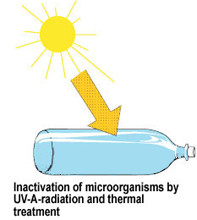Prevention and Treatment of Bowel Infections in Tropical Areas
Water and Food Poisoning Due to Bad Sanitation
Inappropriate sewage disposal may result in contamination of drinking water with human and animal stools containing viruses, bacteria or parasites. Drinking or swimming in such water is the main source of stomach and bowel infections in tropical areas.
If water, contaminated with microbes, is used for watering fields, crops get contaminated. Improper food storing (no cooling) and bad hygiene (no hand washing) are additional causes of food poisoning with bacteria or parasites. Infestation with intestinal worms, a huge health problem in rural tropical areas, can be attracted by walking barefoot, or swimming in contaminated rivers and lakes.
Prevention Of Gastrointestinal Infections in Tropical Areas
Latrines
Using latrines can help to keep the sources of drinking water clean.
Vaccination Against Rotavirus
All children under 5 years of age should be vaccinated against rotavirus with oral vaccine. In poor countries, vaccination has greatly reduced mortality from viral diarrhea in last years.
Point-of-Use (POU) Water Treatment
1. Boiling
Boiling of water can kill most live microbes in a minute.
2. Chlorination
Sodium hypochlorite solution (household bleach) or calcium hypochlorite tablets are put in a container with water. Released chlorine kills most of harmful microorganisms (except cryptosporidium) in 30 minutes; chlorinated water is safe to use for the next 24 hours. There are conflicting opinions about cancerogenic effect of chlorination byproducts such as chloroform, but current scientific data show that the benefit of chlorinating is much greater than health risk arising from bowel infections (1).
3. Solar Disinfection (SODIS)
Water is put in plastic (or glass) bottles and placed on a sunny place. Ultraviolet rays kill most microorganisms in 6 hours on a bright sunny day. In cloudy weather, 2 days of exposure is needed; however, on a rainy day SODIS is not efficient way of water disinfection (9). SODIS disinfect only relatively clear water (Picture 1).

Picture 1. Solar disinfection of water (SODIS)
4. Ceramic Filters
Ceramic filters can remove most of bacteria and parasites, but usually not viruses; many types of ceramic filters exist. Disadvantage of ceramic filters is a slow filtration rate (0.5-4 litres/day) (10).
5. Biosand Filters
Biosand filter is made of layers of sand put in a concrete container. When water is poured through the sand, organic substances build a biological layer on the surface of the sand. In 1-3 weeks, microorganisms colonize this layer and destroy harmful microorganisms in the water. Additional filtering is provided by attachment of microbes to the sand grains.
6. Rainwater Harvesting
Rainwater harvesting is possible in areas with enough rain; water is usually caught from the roofs and stored in tanks. Main disadvantages is a contamination with microbes (rainwater has to be chlorinated), heavy metals (roofs, tanks) and chemicals from the environment (12).
Treatment of Diarrhea in Poor Countries
What to consider when treating diarrhea in poor tropical countries:
- Oral rehydration solutions provided by the World Health Organization (WHO-ORS), as a prepared powder mixture of electrolytes, should be used with boiled water in all children under 5 years of age with acute diarrhea to prevent dehydration.
- Zinc, 10-20mg/day for 10-14 days, shortens the duration of acute and chronic diarrhea, reduces stool amount and reduces further episodes of diarrhea in next 2-3 months (2).
- Vitamin and mineral supplements should be given, according to their levels in the blood.
- Enough calories and proteins have to be provided.
All these measures have recently greatly reduced diarrheal diseases in poor countries, however, 2.2 million children worldwide still die each year from diarrhea.
Typhoid Fever
Salmonella typhi causes typhoid fever (enteric fever); infection affects only humans, mainly in Africa, Latin America and South Asia. First symptoms are slowly progressing fever, up to 40°C (104°F), abdominal pain and relatively slow heart beat. After a week, diarrhea, enlarged liver and spleen, and rose spots (3-4 mm) on the chest appear. Despite successful antibiotic treatment, some people may become salmonella carriers – bacteria remain trapped in their gallbladder and are released with their stool, which is contagious. Gallbladder removal in combination with antibiotics treats the condition (5). Vaccine, which is not effective in all cases, is available. Preventive use of antibiotics does not help. NOTE: the only thing typhoid fever has in common with typhus is the rose skin rash.
Tropical Sprue
Tropical sprue is an intestinal malabsorption disorder of an unknown origin (possibly infection), which affects mostly adult residents or visitors of Caribbean area or South Asia. The main symptom is chronic diarrhea. Due to malabsorption of iron, folate and vitamin B12, anemia may develop. Diagnosis is made by biopsy (investigation of a sample of small intestinal mucosa) and history of long (more than 1 month) visits to the tropics; symptoms may appear months or years after a travel (6).Treatment with antibiotics usually results in full recovery in a few weeks, but sometimes disease recurs(7).
Cholera
Cholera, caused by bacterium Vibrio cholerae, which in last decade occurs mainly in India and sub-Saharan Africa, is mostly caught by drinking water contaminated with human stool. Profuse, painless, watery, mucous diarrhea and vomiting may result in severe dehydration within a day; without treatment, it may kill an adult in few hours. Oral rehydration solution, or intravenous Ringer lactate, is effective in most cases; additional antibiotic may shorten the course of diarrhea. Oral cholera vaccine (OCV) provides protection in over 80% of cases (8).
References:
- Water chlorination (americanchemistry.com)
- Zinc supplementation in diarrhea (eddcontrol.org)
- BSS or Pepto Bismol (cptips.com)
- Effect of combination of Rifaximin and loperamide in itestinal infections (docguide.com)
- Typhoid fever (emedicine.com)
- Tropical sprue – incubation period (gideononline.com)
- Tropical sprue (merck.com)
- Cholera (who.int)





